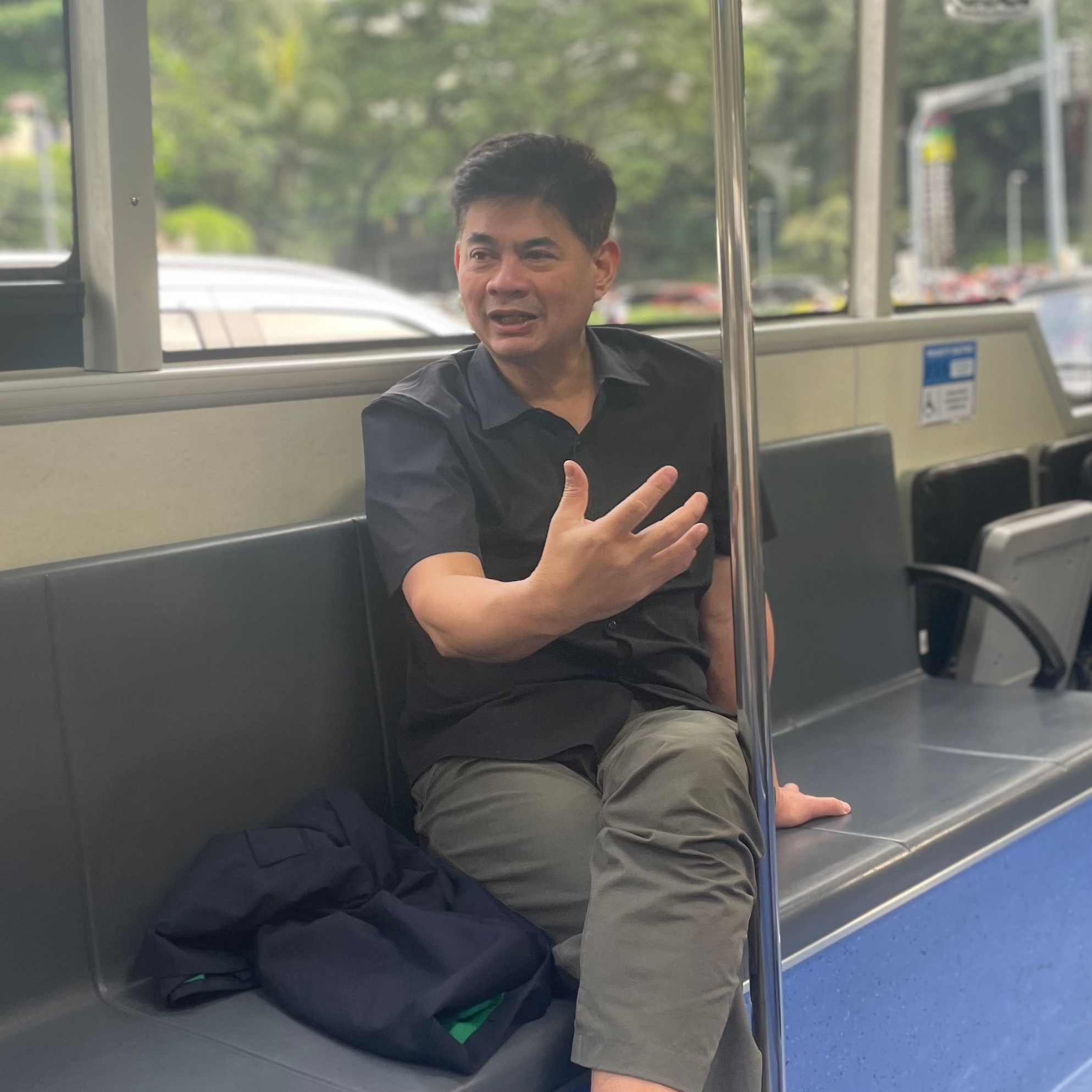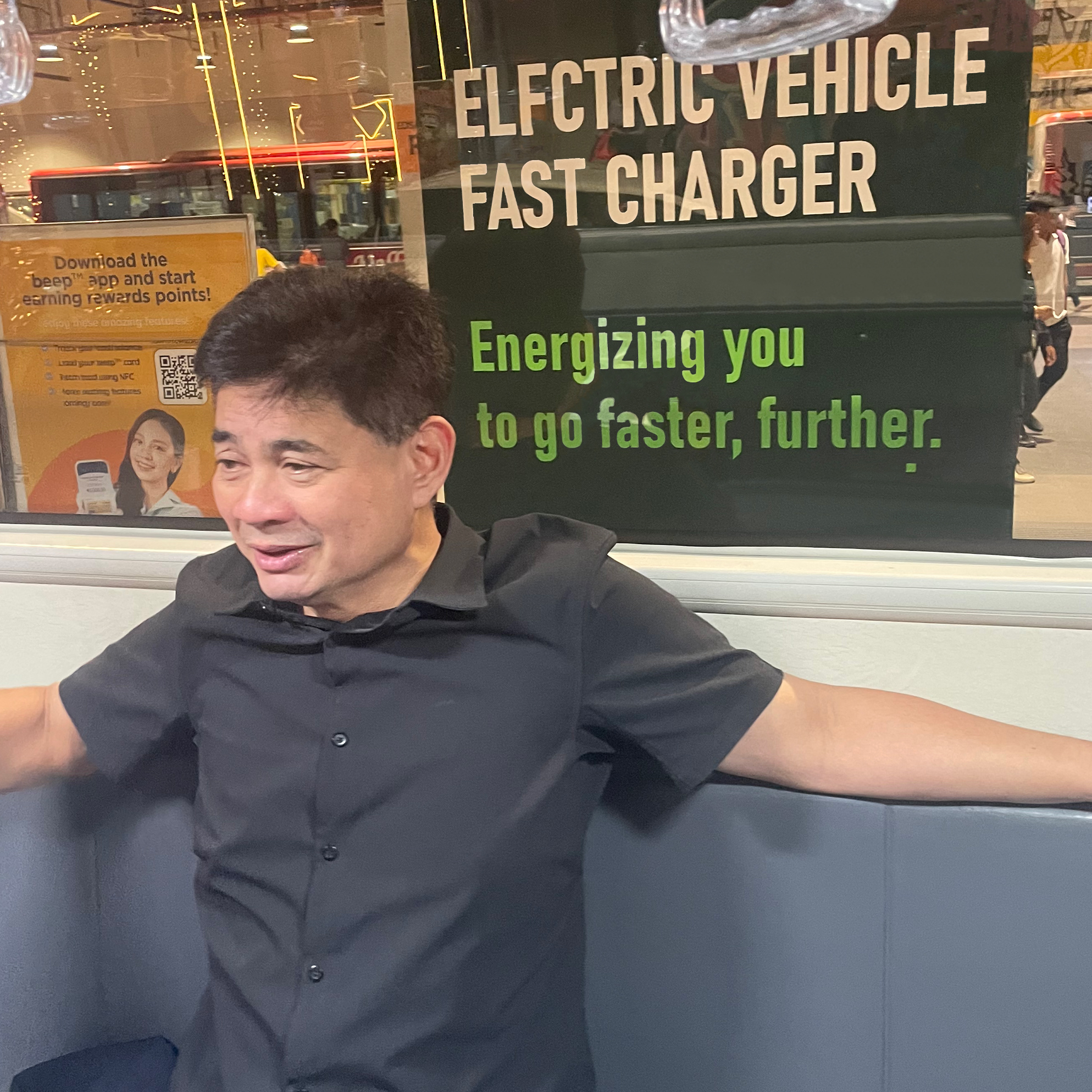“Enjoy the Manila traffic,” quips Freddie Tinga with a giggle as he ushers guests into his electric minibus called Comet operated by GET (Global Electric Transport), of which he is the founder and president. Cruising along the streets of the Makati business district that late afternoon, congestion was starting to build up.
For the city’s legion of office workers, it was another day when three hours or more of commute to get home was a given. For Tinga, however, it was a problem to be solved. “Public transportation is such a pain,” he laments. “It leads to the problem of all these cars. The minute you can afford to buy a car, you do; even though you are adding to the traffic and making the situation worst.”
His goal, he continues, is to create a public transport solution that addresses the needs of the masses. At the same time, it is also zero emission by deploying electric buses. At GET, the solution is also tech-enabled via an app, which the company developed to automate cashless fare collection. “We are a tech company disguised as a transport company,” he suggests.
The immediate opportunity for GET is the country’s long-delayed Public Utility Vehicle Modernization Programme (PUVMP). Mandated in June 2017 by the previous government, it requires individual operators of the traditional jeepneys to organize into a cooperative or a corporation with at least 15 vehicles before they can apply for a new franchise.
Public transportation in the Philippines can be an emotive issue. It is not just because of the iconic jeepneys that ply the streets – remnants of the American military jeeps that were left behind after World War II that the country is often associated with – but also because of the number of drivers and operators involved. Transport strikes accompany each deadline to enforce the programme. In the latest move, the new government has moved the deadline for the third time to the end of April 30 2024.
Over 300,000 jeepneys ply the streets in the Philippines, of which 80,000 are in Metro Manila. They are the primary means of transport for most Filipinos. They are appealing because you can hop on and hop off anytime, anywhere. But that also is the source of the daily traffic chaos; they are also polluting; many are old, decrepit, and unsafe.
According to Tinga, jeepneys account for 48% of the particulate matter released into the atmosphere. In addition, each jeepney spews out 1,000 kg of carbon dioxide a month, adding to the carbon footprint. Traditional jeepneys consume 10,000 litres of diesel per year, while the air-conditioned Euro 4 versions consume 18,000 litres of diesel yearly.
A new business model
Switching to electric public transport, therefore, makes sense. But the electric minibuses as proposed by Tinga comes at a price that is relatively more expensive. Each tailor-made electric bus costs around 4.5 million pesos (US$80,000), which is well above alternatives that cost anywhere from 1.4 million pesos to 3 million pesos.
To support the modernization programme, the Land Bank of the Philippines and the Development Bank of the Philippines were tasked to provide the financing. Over 3,000 vehicles have been financed with the vast majority for Euro 4 diesels. “These vehicles continue to pollute and use expensive diesel fuel,” he laments. “Since Euro 4 engines are already banned in most countries, lack of spare parts becomes an issue when these vehicles break down.”
For the more expensive electric buses, Tinga agrees the issue is funding. “The jeepney operators don’t have money,” he recognizes. To bridge the gap, he proposes to split the cost of the vehicle with the operators who can then go to the bank to finance the rest. “I come in to cover 2.25 million pesos; then we profit-share.”
GET is also taking care of all repair and maintenance of the electric bus. “If I am a jeepney owner, I should be happy since I did not cough up any amount and I have a new vehicle,” he explains. With the profit share arrangement with the operators, Tinga is confident that the operators will still secure their income, which is anywhere from 10,000 pesos and up to 20,000 pesos per vehicle per month.
Why this works for GET is because of Tinga’s belief that the future is about mobility as a service. “The money is in operations, it is not in manufacturing, which is what we’ve always said. This is not a business where we make money selling the vehicle. This is a business where we make money as people contract us, as people ride.”
GET’s business model wraps revenue from advertising as well as the rich data that it collects to augment the fare income. “We have over a million subscribers using the app; our top riders are approaching 600 rides over two years. This is what the business is about – repeat business. If we can create that, we see so many opportunities.” And he sees the Philippines as a test bed for GET’s ambition to go global. Enquiries he has received come from as far as Ecuador, India, South America and Southeast Asia
Bumpy road
Although Tinga is better known for his three terms as mayor of the city of Taguig from 2001 to 2010 – where the Bonifacio Global City is located – and a single term in Congress, he has been somehow involved in information technology including with the former Andersen Consulting (now Accenture) and at Siemens-Nixdorf. He also worked at Citibank Manila with its consumer banking division. Just before his switch to the government, he founded K2 Interactive, what he reckons is a pioneer business process outsourcing specializing in design, tech, and business strategy. It was eventually bought by Publicis Groupe, a global advertising and public relations company.
But it was his stint in government that eventually led him to start GET. “If you want to see problems up close, join government. You cannot escape the problem,” he relates. “To fix them, you need to do that from the outside. The (government) system is tough with innovation; it is tough on pushing boundaries – if you cross the line (in government), your head will be chopped.”
During his final term as the mayor of Taguig, he started experimenting with electric tricycles. “We have about 100 of these running around Taguig as an experiment. We were getting batteries and motors from China. If you want something solid, they have to have lithium batteries. But then they become more expensive. And tricycles do not have the capacity to generate the revenue to offset the capex investment. The maths does not work.”
 Freddie Tinga hopes to promote more electric mini-buses in the Philippines.
Freddie Tinga hopes to promote more electric mini-buses in the Philippines.
In Congress, Tinga was involved also with Gawad Kalinga, a community development foundation. One of its biggest benefactors is Anthony Olaes, who headed up the US chapter of the foundation. When Tinga left government ten years ago, he began to discuss the idea of turning his experience in government into a business with Olaes and zeroed in on the problem of public transport in the country.
“We’ve fallen down on this project so many times,” he recalls. The first bus was with a partner in the US state of Oregon that was producing small electric cars. It came by chance as Tinga finished his MBA at the University of Oregon. “We were running it in Katipunan (a district in Quezon City) servicing students at Ateneo [University] and UP [University of the Philippines]. [Former] President Obama actually visited us in April 2014.”
The following year, one of the vehicles caught fire. It was an embarrassing start. But it was not just the issue of safety, Tinga explains: “We could not get the number of hours needed to make it work; the charging of the batteries was slow.” That experience, however, was instructive. “We learned a lot of what works and what doesn’t.”
When the fire happened, his US partner in the venture “walked away”. For its next prototype, GET switched to working with a Canadian-Taiwanese firm, which he described as “a bunch of smart young engineers”. But the problem they faced was how to get the prototype into production.
It was around 2017/2018, he remembers, when he struck up a discussion with Endika Aboitiz, scion of one the business families in the Philippines and chair of Aboitiz Equity Ventures. Aboitiz was already thinking about getting into EV charging in the country following the PUVMP government mandate.
He brought in his Spanish engineering group that was behind the Formula E, the motorsport championship for electric vehicles, to convert jeepneys into electric vehicles. While the concept had the right technology, it was the wrong approach as jeepneys turned out to be not suitable for the conversion.
“By then, we were running out of funds,” Tinga recalls. He managed to speak with the head of the Spanish engineering group, Miguel Valldecabres Polop, CEO of QEV Technologies. “They were already invested so much in the Philippines. We were kind of stuck. Either we write off everything or we push on.”
Just before the pandemic, Aboitiz revisited his EV charging idea and agreed to fund the acquisition of a number of prototype vehicles for GET. Together, the group decided to operate the prototype vehicles in Davao, a city in Mindanao, with Davao Light and Power, owned by the Aboitiz group, providing free charging. “We wanted to see if the concept works,” remembers Severino Sumulong, the chief legal counsel of GET. “We had developed our app and we were telling riders to download it to try getting on Comet.” Next stop was Metro Manila.
Looking ahead
GET today operates 65 of these Comets and have covered over three million kilometres in the past three years. “Most of our clients are corporates that use us for shuttle service such as Cebu Pacific, Robinson and Ayala,” Tinga elaborates. “We also are serving industrial estates such as in Lima, Batangas.”
The Comets are manufactured in Chongqing, China by EvDynamics, in which Valldecabres joined as CEO and executive director in October 2020. The 53-kilowatt-hour lithium-ion batteries are supplied by CATL, one of the world’s largest battery manufacturers based in Fujian, China, which also supplies Tesla.
At the current number of units, Tinga shares, GET is barely breakeven, generating 250,000 pesos per month in transport and media revenues. “It has the possibility of becoming a big business.”
Tinga thinks that when GET scales up, it could conceivably move the manufacturing for the Comet to the Philippines. In the case of the batteries, he expects that to continue to be from CATL. “Public transport is not the space to experiment with technology. It is best to use what is tried and tested.”
 The 53-kilowatt-hour lithium-ion batteries of the electric-minibuses are supplied by CATL, one of the world’s largest battery manufacturers, which also supplies Tesla.
The 53-kilowatt-hour lithium-ion batteries of the electric-minibuses are supplied by CATL, one of the world’s largest battery manufacturers, which also supplies Tesla.
GET also operates 12 fast chargers mostly in Metro Manila with one each in Cebu and Davao. Tinga says it is the Philippines’ largest fast-charger network at the moment. As it scales, it already has tied up with a supplier to add more charging stations.
To scale up, GET is looking to raise US$25 million to accelerate its acquisition of more COMETs and take over the whole ecosystem. For the PUVMP, GET has signed up with a number of cooperatives to supply about 1,000 units. “Given the requirements of the Philippines, it is just a drop in the bucket. But the effect on us is huge.” He reckons for the Philippine market it could be as much as 500,000 units.
Comfortably ahead
“For us, this a no-brainer for anyone,” Tinga continues. “We don’t want to monopolize. We don’t mind competition. But we are ahead of the game. We have the minibus, we have the charger, we have the app. Putting it all together is not easy. That is what we are finding out.”
A lot of the potential competition, he says, are the “big boys” who are looking into the business. “[But] they are scared to dirty their hands in public transport space,” he suspects. “They are not willing to take the risk of learning the business; of falling down and getting up. It’s not easy for them to do now. We live this every day; we know the problems. We go through the problems every day – get calls from the clients every day.”
He predicts: “This will happen. We are the only electric transport that fits the bill, price-wise, technology-wise. The only question is when and who. Hopefully soon; hopefully us.”








